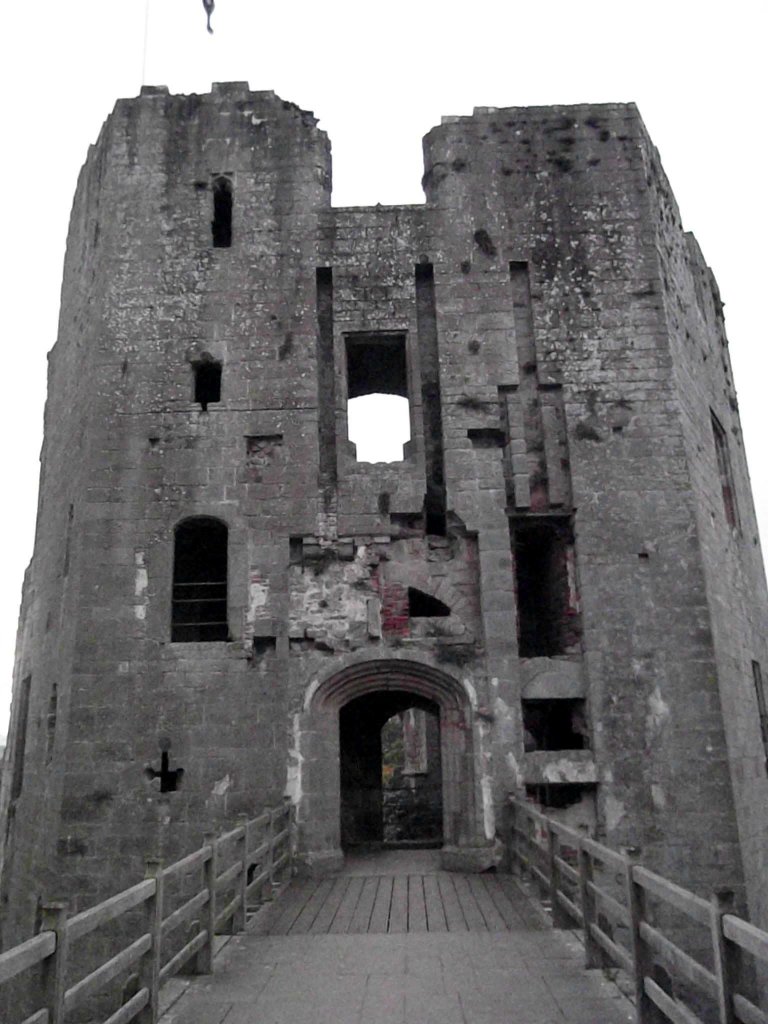 It
is just possible that Raglan castle may have originated as a
motte and bailey when the Normans conquered Gwent in the late eleventh
century. The Bloets held the vill in the twelfth century and then
passed it
on to the Berkeley's in marriage before 1405. In 1432 the manor
was purchased by Sir
William ap Thomas (d.1446), a veteran of Agincourt and the French
wars. He may have started work on the present structure,
although it is possible that the lowest courses of the south gate
belong to a much earlier date. Before William's death around
1446, he built the Great Tower, a massive, moated, keep-like structure
that could only be approached from within the castle via twin
drawbridges in the North French manner, as found at Lassay,
Tonquedec, Loches
and Tiffauges.
In 1461 his son, William Herbert, became Baron Herbert of Raglan and
embarked on a lavish and ambitious building programme to reflect his
new status. He developed suites of accommodation around the
Fountain Court, built the Pitched Stone Court, and constructed the
gatehouse to both impress and intimidate visitors to the
castle. However, his execution in 1469 left the work
unfinished and it was not until the castle passed to the Somerset earls
of Worcester, that Raglan underwent its final transformation.
Earl William Somerset remodelled the hall range, built a long gallery
and extended the Pitched Stone Court in the latter part of the
sixteenth century. He also created a garden with long walled
terraces and a
lake. After his death his son continued to enhance the garden
with a water parterre and bedecked the moat walk with statues of Roman
emperors. Unfortunately, the castle experienced deliberate
destruction during the Civil War after it had been besieged for ten
weeks in 1646 by parliamentarian troops.
It
is just possible that Raglan castle may have originated as a
motte and bailey when the Normans conquered Gwent in the late eleventh
century. The Bloets held the vill in the twelfth century and then
passed it
on to the Berkeley's in marriage before 1405. In 1432 the manor
was purchased by Sir
William ap Thomas (d.1446), a veteran of Agincourt and the French
wars. He may have started work on the present structure,
although it is possible that the lowest courses of the south gate
belong to a much earlier date. Before William's death around
1446, he built the Great Tower, a massive, moated, keep-like structure
that could only be approached from within the castle via twin
drawbridges in the North French manner, as found at Lassay,
Tonquedec, Loches
and Tiffauges.
In 1461 his son, William Herbert, became Baron Herbert of Raglan and
embarked on a lavish and ambitious building programme to reflect his
new status. He developed suites of accommodation around the
Fountain Court, built the Pitched Stone Court, and constructed the
gatehouse to both impress and intimidate visitors to the
castle. However, his execution in 1469 left the work
unfinished and it was not until the castle passed to the Somerset earls
of Worcester, that Raglan underwent its final transformation.
Earl William Somerset remodelled the hall range, built a long gallery
and extended the Pitched Stone Court in the latter part of the
sixteenth century. He also created a garden with long walled
terraces and a
lake. After his death his son continued to enhance the garden
with a water parterre and bedecked the moat walk with statues of Roman
emperors. Unfortunately, the castle experienced deliberate
destruction during the Civil War after it had been besieged for ten
weeks in 1646 by parliamentarian troops.Copyright©2019
Paul Martin Remfry